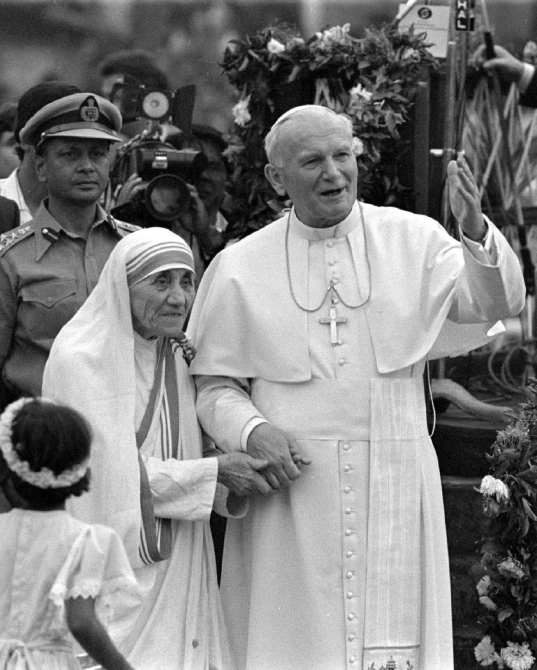 What is strange, for someone who spent a lifetime in seva, is that St Teresa's own personal journals and communication with the Church hierarchy reveal someone in “spiritual desolation", says Sankrant Sanu. Could the Indian sacred traditions have helped her out of her dark night?
What is strange, for someone who spent a lifetime in seva, is that St Teresa's own personal journals and communication with the Church hierarchy reveal someone in “spiritual desolation", says Sankrant Sanu. Could the Indian sacred traditions have helped her out of her dark night?
Mother Teresa’s sainthood has been welcomed by many who see her as an exemplar of a frugal life of selfless service. There have equally been many critiques about Teresa’s canonisation by the Church, including her woeful neglect of those under her care (sharing needles when she herself got first class care), financial fraud (raising money that enriched the Vatican, but didn’t go to helping the poor) and hobnobbing with dictators, and justifying Indira Gandhi’s Emergency.
Many of her trenchant critics, like the late Christopher Hitchens, have been atheists. Small wonder, then, the paradox of her spiritual journey has been overlooked. For someone who had spent a life in service of God, she was lonely and desolate, feeling no presence of the divine in her life for decades, “a state that lasted until her death, according to her letters” published in 2007 (external link).
I write about Mother Teresa with some care. Though I have criticised her on social media, two very dear friends of mine were associated with her and were also married in her presence (though they later divorced.). They had been quite taken by her; clearly she was a woman of her faith and her personal work in service is also undeniable.
What is strange, for someone who spent a lifetime in seva, is that her own personal journals and communication with the Church hierarchy reveal someone in “spiritual desolation.” This is a claim not by atheists, but by herself and her Christian chroniclers, based on her correspondence compiled in the book Mother Teresa: Come be My Light, by Rev Brian Kolodiejchuk, postulator for her sainthood.
A Fox News headline from 2007 (external link) summarises it best: ‘Mother Teresa Did Not Feel Christ's Presence for Last Half of Her Life, Letters Reveal.’ Soon after starting her work in Calcutta, she expressed great doubts, feeling no presence of God and even doubting that God existed. After she had been given the Nobel Prize she felt her public image was a sham and felt like a hypocrite.
‘Her smile to the world from her familiar weather-beaten face was a “mask” or a “cloak”,’ she said. ‘What do I labor for? If there be no God, there can be no soul. If there be no soul then, Jesus, You also are not true.’
Her sentiments would befit an agnostic or even an atheist.
‘I feel just that terrible pain of loss, of God not wanting me, of God not being God, of God not really existing.’
Christianity Today characterises her hidden correspondence as revealing a ‘lonely, spiritually desolate Mother Teresa’, someone who carried the ‘dark night of the soul’ for her ‘whole working life’, ever since she started her missionary work in Calcutta.
In Western accounts, there are two explanations for this. For “believing Christians” such as Jesuist Priest Rev James Martin, Teresa’s long desolate joyless separation “moves into the ranks of the greatest saints,” as “very few who have suffered such an extended dark night.”
This is very much in line with the Christian narrative where suffering and religiosity go together, the symbol and exemplar being Jesus and his crucifixion. The atheist explanation is simpler. Teresa’s trenchant critic, Christopher Hitchens, had this explanation when asked about her doubt:
‘She was no more exempt from the realisation that religion is a human fabrication than any other person, and that her attempted cure was more and more professions of faith could only have deepened the pit that she had dug for herself’ (as quoted in Time in 2007).
So Teresa had finally come to the realisation that God didn’t exist, though, per Hitchens, she continued like brainwashed “die-hard Western communists late in the Cold War.” Even after the Soviet Union failed ‘they carried on somehow, but the mainspring was gone.’
The atheist explanation comes up with the ‘no God’ answer and the Christian explanation with the ‘proves faith’ answer. But is there a third way to look at it?
From the point of view of Indian spiritual traditions, this is a strange situation. For someone whose life was presumably unconditional giving, nishkama karma, joy would be a spontaneous outcome. Our very nature is bliss, sat-chit-ananda. Someone who had realised their nature, a jivamukta, an enlightened master, would be in a state of bliss. The “dark night of the soul” such as it is, would be only a temporary setback; and certainly not a lifetime event for someone declared a saint.
Even in the wide field of the Indian traditions, from the Buddha, Shankaracharya or modern saints like Ramana Maharishi or Ramakrishna Paramhansa, or even someone like Kabir or Mirabai, there would be a pain of longing, but it would be a sweet pain; while communion with the divine would be practically constant. Life would not be “excruciating suffering” in “darkness” and confusion for decades all the way till their death.
This spiritual darkness lasted for her for nearly 50 years, till her death in 1997, but for a brief hiatus. How does one explain this?
One explanation could be that Teresa was not really engaged in seva, unconditional service. Her concern was less for taking care of the poor but for the Church dogmas she believed to be true. Per these dogmas, the worldly suffering did not matter since by Christian Baptism the poor would get everlasting heaven.
In this video (external link) she talks of her conversions, "29,000 in one house alone". 'Not one has died, without receiving the ticket for Saint Peter, we call it. We call Baptism, ticket for Saint Peter. 29,000 have died in that one house.'
The poor under her care, as secular critics have pointed out, were treated quite poorly and told to embrace their suffering, as Jesus did. The emphasis was on baptism, suffering and death, to get “eternal heaven”, not on healing and service. The seva was thus conditioned, born from attachment to wrong concepts.
Of course, a “saint” in the Church is not an enlightened being or even a person that serves humanity; but simply one that passes its bureaucratic tests of two incredulous miracles. Only dead people are sainted, a live saint could challenge the authority of the Church.
Sri Sri Ravishankar speaks of the 3 S’s -- Seva, Sadhana and Satsang -- going together. Joy is a natural outcome as is presence of the divine. For all her work, Mother Teresa would have been helped out of the “dark night of the soul” by any one of the spiritual preceptors and gurus in India, along with many other practices from the Indian traditions.
Unfortunately Teresa came only to “save” the natives of India and, unlike other Westerners who come to India to dip into its deep spiritual traditions, managed to learn little. Tightly bound in the straitjacket of right-wing Catholic dogma and subservient to Catholic patriarchy (external link), she remained parched -- as she mentions in her 1995 letter, in “spiritual dryness” -- unable to drink from the plentiful fresh spring waters of her adopted land.
But her one foretelling would be accurate. “If I ever become a saint I will surely be one of ‘darkness’.”
Image: A file photograph from February 3, 1986, of Pope John Paul II with Mother Teresa after visiting her home for the destitute and dying in Kolkata. Photograph: Rediff.com Archives.







